Fermenting Beer with Fermentis SafBrew LA-01 Yeast
Published: August 21, 2025 at 9:16:08 AM UTC
Fermentis SafBrew LA-01 Yeast is a dry brewing strain from Fermentis, part of the Lesaffre group. It was developed for low- and non-alcoholic beer production. It's marketed as the first dry NABLAB yeast for beers under 0.5% ABV. This innovation allows U.S. brewers to create flavorful low-ABV beers without the need for expensive dealcoholization systems.
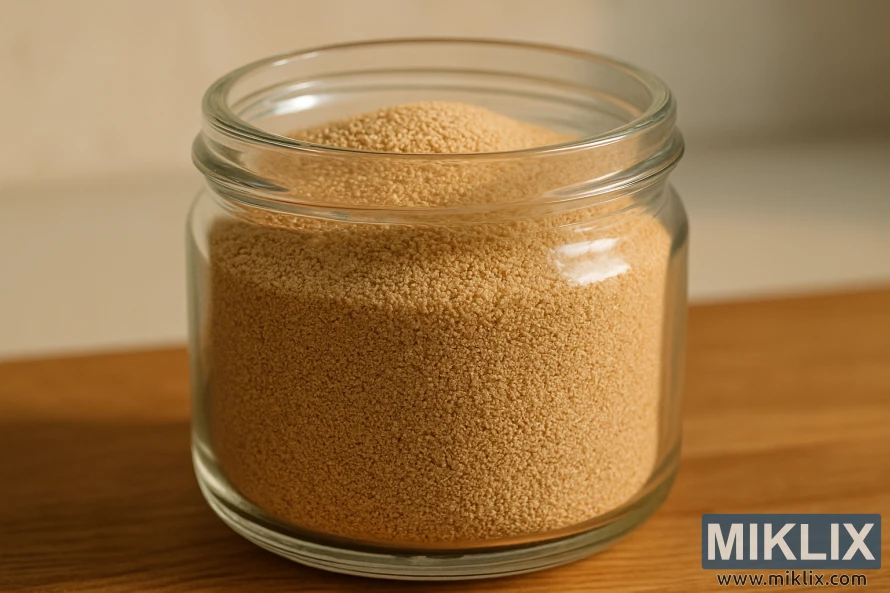
This strain is technically Saccharomyces cerevisiae var. chevalieri. It is maltose- and maltotriose-negative, only fermenting simple sugars like glucose, fructose, and sucrose. This characteristic makes it a reliable choice for non-alcoholic beer yeast, while preserving the flavor precursors brewers desire.
SafBrew LA-01 is available in 500 g and 10 kg formats. It comes with a “best before” date printed on sachets and the backing of Lesaffre’s industrial production standards. This article aims to provide a practical review and guide for brewers interested in using SafBrew LA-01 for brewing low ABV and NABLAB beer styles.
Key Takeaways
- Fermentis SafBrew LA-01 Yeast is designed for low- and non-alcoholic beer production under 0.5% ABV.
- The strain is Saccharomyces cerevisiae var. chevalieri and only ferments simple sugars.
- It enables flavorful beers without dealcoholization equipment, making brewing low ABV more accessible.
- Available in 500 g and 10 kg packaging with Lesaffre quality control and clear shelf dates.
- This guide reviews strain traits, handling, and practical brewery use cases.
Why Choose Fermentis SafBrew LA-01 Yeast for Low- and No-Alcohol Beer
The demand for low- and no-alcohol beers is on the rise, presenting breweries with a significant opportunity for growth. Fermentis has developed SafBrew LA-01 to cater to this market need. This yeast allows brewers to expand their offerings and attract a broader consumer base with minimal investment.
One of the key advantages of using SafBrew LA-01 is the quality it preserves. Unlike traditional dealcoholization methods, this yeast avoids the costly equipment and flavor loss associated with them. It ensures cleaner fermentation profiles and fewer off-flavors, making it a superior choice for low-alcohol beers.
The versatility of SafBrew LA-01 is another significant benefit. It produces subtle aromas that complement a wide range of beer styles, from pale ales to malty-biscuity brews and even kettle-soured beers. This flexibility empowers craft brewers to experiment and innovate while maintaining their focus on low ABV beers.
Practical advantages for breweries are also noteworthy. SafBrew LA-01 supports the NABLAB benefits by allowing production on standard brewery equipment. This simplifies the process for breweries looking to introduce non-alcoholic and low-alcohol options without significant changes to their operations.
Aux Enfants Terribles, in collaboration with Fermentis, has successfully created no- and low-alcohol pale ales and a kettle-soured non-alcoholic sour. These projects demonstrate the wide appeal and versatility of low-alcohol beers, proving they can resonate with a broad audience.
Low ABV brewing offers additional benefits, such as improved mouthfeel and perceived body when combined with techniques like kettle souring. Brewers can achieve a perfect balance of acidity and malt character, resulting in NABLABs that are both satisfying and complete on the palate.
For brewers considering their options for low-alcohol beers, SafBrew LA-01 stands out as a practical and effective choice. It enables breweries to offer a range of low-alcohol options without compromising on flavor or process complexity, making it an ideal solution for those looking to cater to a wider audience.
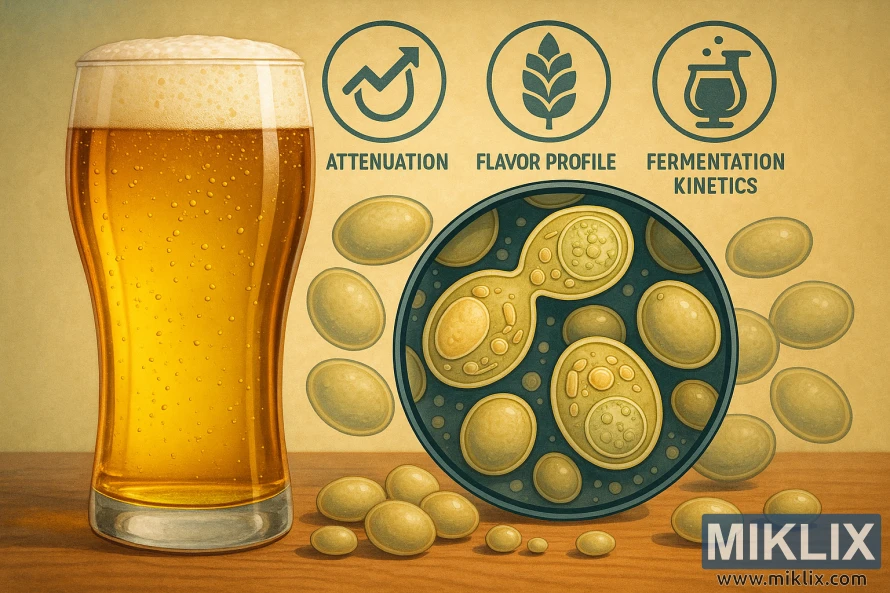
Saccharomyces cerevisiae var. chevalieri: Strain Characteristics
Fermentis SafBrew LA-01 is a member of Saccharomyces cerevisiae var. chevalieri, selected for use in low- and no-alcohol beers. It is a maltose-negative yeast, unable to ferment maltose or maltotriose. Instead, it consumes simple sugars like glucose, fructose, and sucrose. This results in very low alcohol levels and predictable attenuation.
The strain is classified as POF+ yeast under certain conditions, producing phenolic notes reminiscent of clove or spice. Brewers can control these phenolic characteristics by adjusting mash pH, oxygenation, and fermentation temperature. This helps in reducing phenol expression.
The yeast's sensory output is subtle and restrained. It has very low total esters and low higher alcohols. This preserves the delicate flavors of malt and hops in non-alcohol or low-alcohol beers. It's ideal for styles requiring a clean, light base.
Flocculation is medium, with cells settling gently. When disturbed, they form a powdery haze instead of heavy flocs. This trait aids in recovery during centrifugation or filtration, ensuring consistent packaging clarity.
- Viability: >1.0 × 10^10 cfu/g, ensuring reliable pitch rates.
- Purity: >99.9%, with target contaminants kept extremely low.
- Microbial limits: lactic and acetic acid bacteria, Pediococcus, and wild yeasts each under 1 cfu per 10^7 yeast cells; total bacteria
These traits make Saccharomyces cerevisiae var. chevalieri desirable for brewers. They seek consistent low alcohol, controlled phenolics, and a neutral yeast sensory profile. This highlights other recipe elements.
Fermentation Performance and Sensory Profile
Fermentis SafBrew LA-01 exhibits unique traits for low-ABV brewing. Its low apparent attenuation is due to its maltose-negative nature, limiting alcohol production to under 0.5% ABV. Lab tests focus on alcohol production, residual sugars, flocculation, and fermentation speed to evaluate its performance.
Residual sugars are critical for mouthfeel in low-ABV beers. LA-01 consumes simple sugars, leaving maltose and maltotriose behind. This preserves body and malty character, preventing NABLABs from tasting thin. The presence of residual dextrin enhances mouthfeel, a goal for many brewers.
The sensory profile of LA-01 is clean and restrained. It has very low total esters and higher alcohols, creating a subtle backdrop for hops and malt. Practical trials reveal a juicy, tropical hop profile on a biscuity pale malt base. Bright citrus notes are also achievable in kettle-soured non-alcoholic sours, depending on brewing techniques.
As a POF+ strain, LA-01 can produce phenolic spice or clove. To minimize phenolic notes, brewers can adjust wort composition, control pitching rates, and maintain cooler fermentation temperatures. Modifying recipes to reduce specific precursors also helps achieve a neutral flavor profile.
- Attenuation low-alcohol yeast behavior: predictable, maltose-negative, useful for sub-0.5% ABV targets.
- Residual sugars in low-ABV beers: contribute body and malt character, improving perceived fullness.
- Sensory profile NABLAB: low esters and higher alcohols, letting hops and malt speak clearly.
Adjunct methods enhance LA-01’s versatility. Kettle souring introduces bright acidity while preserving body. Blending with Saccharomyces strains like SafAle S-33 can increase complexity and mouthfeel without exceeding alcohol limits. These techniques empower brewers to craft both the fermentation performance and the sensory profile of their beers.
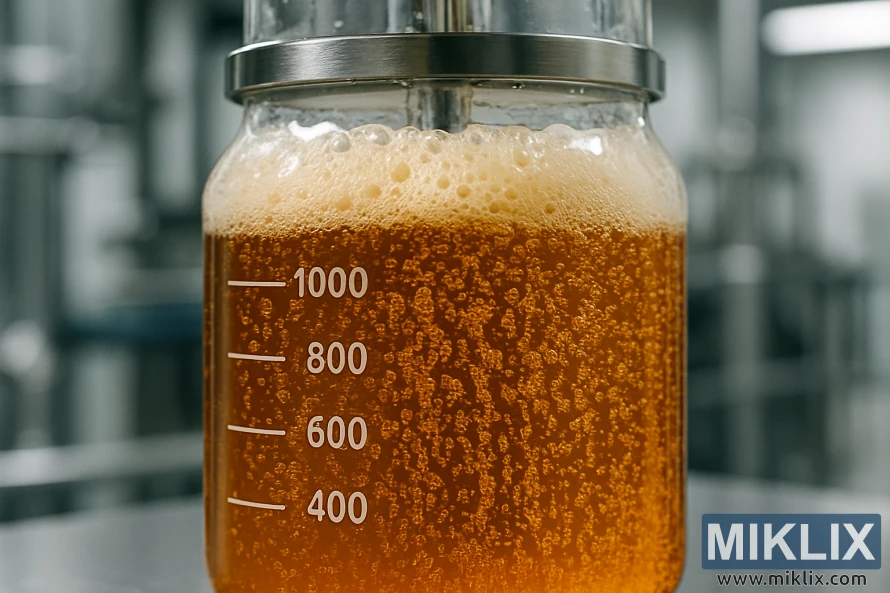
Dosage, Pitching and Temperature Guidelines
For most low- and no-alcohol recipes, use a SafBrew LA-01 dosage of 50–80 g/hl. This dosage supports steady fermentation and predictable attenuation when other variables are controlled.
When determining the pitching rate LA-01, match it to your wort gravity and volume. Laboratory trials are essential before scaling to production. They help confirm alcohol, residual sugar, and flavor outcomes under local conditions.
Target a fermentation temperature LA-01 between 15–25°C (59–77°F). This range preserves ester control and fermentation kinetics specific to Saccharomyces cerevisiae var. chevalieri. It also allows for flexibility in achieving desired sensory profiles.
Follow clear yeast pitching guidelines, whether you plan to sprinkle or rehydrate. If adding dry yeast directly to the fermenter, do so during early filling. This ensures the yeast disperses across the wort surface and avoids clumping.
When rehydrating, use at least 10× the yeast weight in sterile water or cooled boiled hopped wort at 25–29°C (77–84°F). Rest the slurry for 15–30 minutes, stir gently, then pitch to the fermenter.
- Do not expose rehydrated yeast to extremes of temperature when adding to the wort.
- Adjust dose within 50–80 g/hl for higher gravity worts or faster starts.
- Monitor viability with small trials to refine your pitching rate LA-01 for consistent results.
Fermentis dry yeasts are designed to tolerate cold or no-rehydration use without harming viability or analytical profile. This design gives brewers options to match yeast pitching guidelines to their process and equipment.
Run pilot fermentations before commercial batches. Trials help verify that your SafBrew LA-01 dosage, fermentation temperature LA-01, and pitching practices deliver the target alcohol level, mouthfeel, and sensory balance.
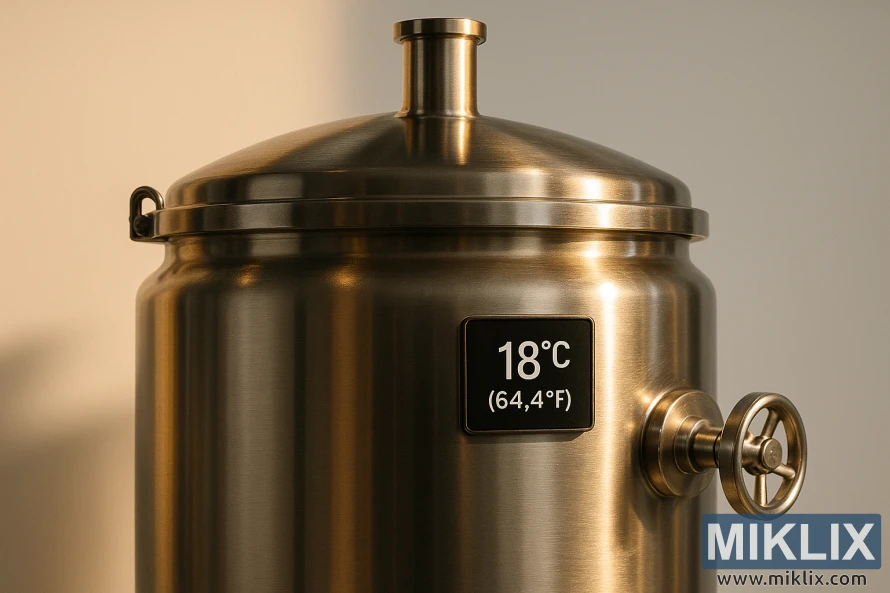
Pitching Methods: Direct vs. Rehydration
When deciding between direct pitching LA-01 and rehydration SafBrew LA-01, consider scale, sanitation, and speed. Direct pitching involves sprinkling dry yeast evenly over the wort surface. This can be done while filling or once the temperature is within range. It's important to spread the yeast to prevent clumping, ensuring even hydration across the volume.
Rehydration SafBrew LA-01 requires a controlled step before pitching. Start by adding the dry yeast to at least ten times its weight of sterile water or boiled, cooled hopped wort. The temperature should be between 25–29°C (77–84°F). After a 15–30 minute rest, gently stir to create a creamy slurry. This slurry is then transferred to the fermenter.
Fermentis has formulated dry yeasts like LA-01 to perform well even in cold or no-rehydration conditions. This makes dry yeast pitching methods suitable for many breweries. They are ideal where strict sanitation and small batch control are priorities.
Operational factors influence the choice between rehydration and direct pitching. Rehydration demands sterile or boiled medium and precise temperature control to avoid thermal shock. Direct pitching is better for large-scale operations where staff can ensure even distribution during filling. Both methods require intact sachets and adherence to viable-use windows for opened packages.
- How to pitch LA-01 by direct method: sprinkle progressively over the wort surface during early filling or at target ferment temperature.
- How to pitch LA-01 by rehydration: hydrate in 10x sterile water or boiled wort at 25–29°C, rest 15–30 minutes, stir into a cream, then add to fermenter.
Good hygiene is critical for both methods. Use sterile water or boiled and cooled hopped wort for rehydration. Avoid damaged packets. Select the method that aligns with your brewery’s routines, staff skills, and sanitary control to maintain consistent fermentations.
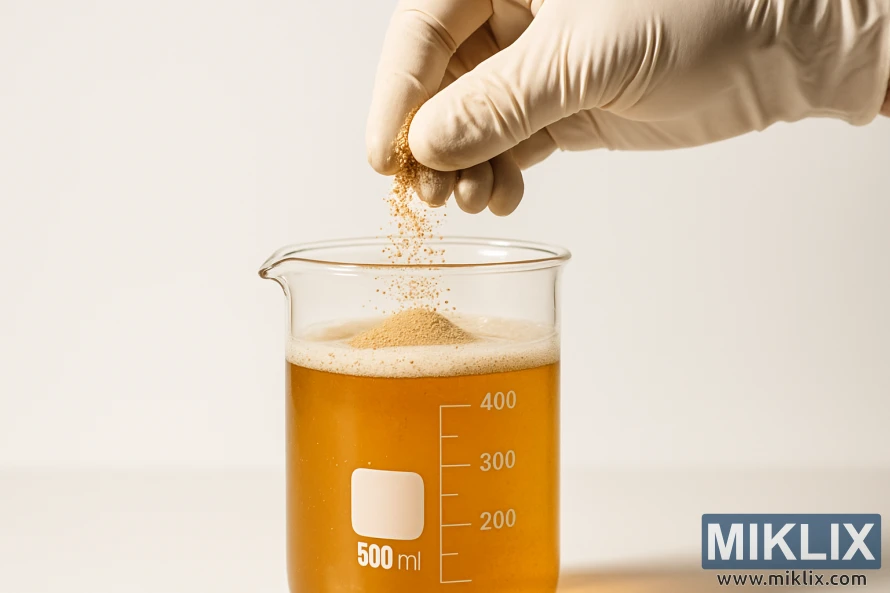
Yeast Handling, Storage and Shelf Life
Always check the printed dates on each sachet for the yeast's shelf life Fermentis. At the time of production, the yeast count is over 1.0 × 10^10 cfu/g. This ensures reliable pitching when storage guidelines are adhered to.
For short-term storage, keeping the yeast under 24°C for less than six months is acceptable. For longer storage, keep SafBrew LA-01 below 15°C to preserve its activity. Brief temperature deviations up to seven days are allowed without significant loss of viability.
When using an opened sachet of yeast, it's important to handle it with care. Reseal the opened sachet and store it at 4°C (39°F). Use the resealed product within seven days to ensure its performance and microbiological quality.
Before using the yeast, inspect the packaging. Do not use sachets that are soft, swollen, or damaged. Lesaffre's production controls ensure high microbiological purity and low contaminant levels, safeguarding fermentation outcomes.
- Viability at production: >1.0 × 10^10 cfu/g.
- Purity target: greater than 99.9% with tight limits on lactic and acetic bacteria, Pediococcus, wild yeasts and total bacteria.
- Opened sachet yeast use: refrigerate at 4°C and use within 7 days.
Proper dry yeast handling is essential to avoid moisture, heat, and cross-contamination. Work in a clean area, handle sachets with dry hands, and avoid exposing yeast to direct sunlight or brewery aerosols.
When scaling pitches, prepare mixes with sterile water at recommended temperatures. Keep records of batch codes and dates. This ensures the yeast's shelf life Fermentis and storage history can be traced for quality control.
Fermentation Management and Monitoring
Keep a close eye on gravity decline to track low-alcohol fermentation and confirm the end point. Regular checks on residual sugar show how Fermentis SafBrew LA-01 breaks down simple sugars. This helps verify the final alcohol by volume (ABV) targets, aiming for below 0.5% when necessary. Use calibrated hydrometers or digital density meters and log readings at set intervals for clear trend lines.
Manage mash profile, oxygenation, pitching rate, and temperature to control phenolic output from this POF+ strain. Small tweaks to wort composition and mash schedule can reduce precursors leading to unwanted phenolics. If phenolic notes appear, slightly lower fermentation temperature or raise the pitch rate to suppress excessive expression.
Observe LA-01 fermentation kinetics and flocculation behavior during conditioning. Expect medium sedimentation with a dusty haze that can resuspend; note sedimentation time and plan maturation appropriately. Combine NABLAB fermentation control techniques—kettle souring or blending with a neutral strain like SafAle S-33—to boost acidity, body, and hop clarity when desirable.
Run lab-scale or pilot batches to refine ester, higher-alcohol, and phenolic balance before full production. Perform sensory checks and collect customer feedback to validate recipes. Many breweries use panels or polls to choose tap selections. Maintain hygienic rehydration and pitching routines and follow Fermentis guidelines to protect yeast viability and ensure consistent, drinkable low-ABV beer.
Conclusion
Fermenting beer with Fermentis SafBrew LA-01 offers brewers a reliable, high-quality solution for crafting flavorful low-alcohol and non-alcoholic beers. This specialized Saccharomyces cerevisiae strain is designed for limited fermentation of maltose and maltotriose, resulting in beers with minimal alcohol content while retaining the full body, aroma, and complexity of traditional brews. Its unique metabolic profile ensures that the wort’s original character is preserved, providing a robust base for creative recipe design.
One of the primary advantages of SafBrew LA-01 is its predictable performance. With careful control of fermentation parameters—particularly temperature, pitching rate, and sanitation—brewers can achieve consistent results, avoiding unwanted off-flavors and ensuring microbial stability. The yeast’s optimal working range of 10–20 °C makes it versatile for different brewing setups, while its neutral fermentation profile allows hop and malt notes to shine without yeast-derived interference.
In addition, its compatibility with standard brewing equipment means brewers can integrate LA-01 into existing processes with minimal adaptation. Whether producing a crisp, hop-forward low-alcohol IPA or a malt-rich non-alcoholic lager, LA-01 delivers balance and drinkability without compromising quality.
Ultimately, SafBrew LA-01 empowers brewers to meet the growing demand for low- and no-alcohol beer with confidence, precision, and creativity. By combining its targeted fermentation characteristics with sound brewing practices, it is possible to produce beers that satisfy both modern health-conscious consumers and traditional craft beer enthusiasts alike.
Further Reading
If you enjoyed this post, you may also like these suggestions:
- Fermenting Beer with White Labs WLP351 Bavarian Weizen Ale Yeast
- Fermenting Beer with Mangrove Jack's M20 Bavarian Wheat Yeast
- Fermenting Beer with CellarScience Acid Yeast
